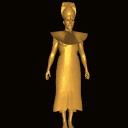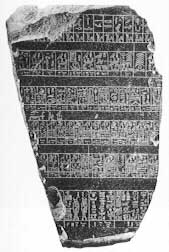 The
Pharaohs
The
Pharaohs

 The
Pharaohs
The
Pharaohs

Egypt was ruled by the pharaoh's. The task of the pharaoh was to
perserve discipline on all the different area's: social and political structure,
the laws of nature, the movement of the stars and planets, the changing of the
seasons and the overgflow of the Nile.
During all the Egyptian history the pharaoh had total power, but of course he
was assisted by a growing amount of civil servants. The Egyptians saw the
pharaoh as a god living on earth. They could only make contact with the gods via
the pharaoh. He had to mediate in favor of the Egyptians, and carry out the
right rituals and offers. Theoretical he was headpriest of every temple in the
country; he nominated other priests and gave the temple's their land land and
earnings.
When the pharaoh died he was kingly burried. His body was embalmed totally, and
mummified. Then they lay him in a tombchamber in the pyramid or tomb he had ordered his
nationals to built.
Sources.
We have 3 sources for the list of pharaohs.
The Palermo Stone that simply lists the kings one after the other, without any apparent need of grouping them.

A fragment of diorite or another dark stone containing information from the early dynasties. The largest piece of the stone is now on display at Palermo, hence its name. A second piece is in the Cairo Museum and an even smaller section is in the University College of London.
The original is believed to have been approximately 2.2 meters long, 0.61 meters high and 6.5 cm thick. It is inscribed on both sides with a list of kings from Pre-Dynastic Egypt to the middle of the 5th Dynasty. From the 4th Dynasty on, the list also contains the foundations and offerings made by the kings. It is thus highly valuable in the study of the foundation of Ancient Egypt.
The exact creation date is not known.
The Turin Kinglist, which is more recent, and has grouped the kings according to their descendance or origin.
the list of Manetho, an Egyptian priest who lived at the beginning of the Ptolemaic Era.We owe the division into 30 dynasties as we use it now to him
Titles.
From the
later half of the 5th Dynasty on, the royal titulary ![]() , nxb.t, consisted of 5 titles or
, nxb.t, consisted of 5 titles or ![]() ,
rn wr,"great names". Each of the titles
expresses a specific view-point on the Egyptian royalty.
,
rn wr,"great names". Each of the titles
expresses a specific view-point on the Egyptian royalty.
The Horus-name
The oldest known part of the royal titulary is the Horus-name ![]() , sometimes also called the banner-name or the Ka-name. It represents the king
as the earthly embodiment of the god Horus,
the divine prototype and patron of the Egyptian kings.
, sometimes also called the banner-name or the Ka-name. It represents the king
as the earthly embodiment of the god Horus,
the divine prototype and patron of the Egyptian kings.
This name is ordinarily written within a rectangular frame, at the bottom of which is seen a design of recessed panelling, such as we find in the facades of early tombs and in the false doors of many private tombs. The Ancient Egyptian name for this facade was serekh. This name is often used in modern texts as well when speaking of the (palace) facade.
On the top of the serekh is perched the falcon of Horus, hence the appellation "Horus-name". In more elaborate New Kingdom examples Horus is wearing the double crown and is accompanied by the sun and a uraeus.
In the Early-Dynastic Period, the perched falcon of Horus was in fact part of the name of the king. Aha, for instance, was actually called Horus-Aha, "Horus who fights".
This name was not the birth name of the king, but it was given to him when he ascended the throne. During the Early-Dynastic Period and the early Old Kingdom, it was the king’s official name. His name of birth would not appear in official documents. This has complicated the identification of many early kings mentioned in the king lists, where only the name of birth is mentioned.
Although it would continue to be used throughout the entire Ancient Egyptian history, it lost its importance to the prenomen en nomen from the end of the Old Kingdom on.
The Nebti-name
The Nebti-name ![]() shows the king in a special relation to two goddesses: the vulture-goddess Nekhbet
of the Upper Egyptian cities of Elkab and Hierakonpolis and the cobra-goddess Uto of the
Lower Egyptian city Buto. Both goddesses are the deified personification of
Upper- and Lower-Egypt respectively, and as such, the Nebti-name denotes the
king as "the one of Nekhbet (Upper-Egypt) and Uto (Lower-Egypt)", i.e. as
the "one belonging to Upper- and Lower-Egypt".
shows the king in a special relation to two goddesses: the vulture-goddess Nekhbet
of the Upper Egyptian cities of Elkab and Hierakonpolis and the cobra-goddess Uto of the
Lower Egyptian city Buto. Both goddesses are the deified personification of
Upper- and Lower-Egypt respectively, and as such, the Nebti-name denotes the
king as "the one of Nekhbet (Upper-Egypt) and Uto (Lower-Egypt)", i.e. as
the "one belonging to Upper- and Lower-Egypt".
Contrary to the Horus-name, which was already used by the Predynastic kings, the Nebti-name expresses the notion of a dual kingship. Den is the first king known to have assumed the Nebti-name. The use of this title by Den may perhaps indicate some governmental reforms that may have occured during this king's reign.
The Greek interpretation of this title as "Lord of Crowns" is secondary and perhaps the result of the temple scenes in which the two goddesses are shown while crowning the king.
The "golden Horus name"
The meaning of the third part of the royal titulary, the
"golden Horus name" ![]() , is (even) more disputed. It represents the falcon god Horus
perched on a symbol that usually represents "gold".
, is (even) more disputed. It represents the falcon god Horus
perched on a symbol that usually represents "gold".
Based on the Greek equivalent of this title on the Rosetta Stone, which translates into English as "superior to (his) foes", it has been proposed that the hieroglyphs symbolised Horus as victorious over Seth, "the Ombite" (another possible reading of the hieroglyph on which the falcon is standing). This was, no doubt, the interpretation of Greek times, when the opposition between Horus and Seth was much more pronounced than in earlier times. For these earlier periods, however, the evidence may point in another direction.
If the "golden Horus name" symbolised Horus’ victory over his enemy Seth, one might expect that the names following this group should be aggressive in nature, but most of the time, those names are far from being bellicose.
Both Kheops of the 4th Dynasty and Merenre of the 6th Dynasty have the title with two falcons over the "gold" sign. These two falcons are frequently used as a symbolic representation of the reconciled gods Horus and Seth. Should the hieroglyph over which Horus is perched represent Seth, we have here an example of Horus and Seth both being indicated as vanquishers of Seth.
In a context dealing with the titulary of Thutmosis III that king says "he (Amun) modelled me as a falcon of gold". Thutmosis III’s co-regent Hatshepsut calls herself "the female Horus of fine gold". The concept of the golden falcon can be definitely traced back to the 11th Dynasty. An inscription of the 12th Dynasty describes the golden Horus name as the "name of gold".
The notion of "gold" is strongly linked to the notion of "eternity". The burial chamber in the royal tombs of the New Kingdom was often called the "golden room", not (only) because it was stacked up with gold, but because it was there for eternity. The "golden Horus name" may convey the same notion of eternity, expressing the wish that the king may be an eternal Horus.
The prenomen
The prenomen is the name that follows the title ![]() "King of Upper- and Lower-Egypt". The oldest known example of this title
is again dated to the reign of 1st Dynasty king Den,
when it was often combined with the Nebti-name discussed above. It would,
however, take until the end of the 3rd Dynasty
before this title really came into use. It would, eventually, replace the
Horus-name as most important official royal name.
"King of Upper- and Lower-Egypt". The oldest known example of this title
is again dated to the reign of 1st Dynasty king Den,
when it was often combined with the Nebti-name discussed above. It would,
however, take until the end of the 3rd Dynasty
before this title really came into use. It would, eventually, replace the
Horus-name as most important official royal name.
The prenomen itself almost always contained the name of the god Re. Typical examples are "pleasing to the heart of Re" (Amenemhat I) and "lord of the cosmic order is Re" (Amenhotep III). One of the first cases of Re as an element in a king’s name is with Khephren of the 4th Dynasty (Khaf-Re).
Every prenomen without Re dates before the 11th Dynasty. The systematic presence of the name of Re in the prenomen indicates that the prenomen was given to the king when he ascended the throne and that it put the king in a narrow relationship with the universal solar god Re.
The title "King of Upper- and Lower-Egypt" can sometimes be
followed by the phrase ![]() "the Lord of the Two Lands", which sometimes even replaces it entirely. A
queen can be called "the Mistress of the Two Lands".
"the Lord of the Two Lands", which sometimes even replaces it entirely. A
queen can be called "the Mistress of the Two Lands".
The nomen
The nomen is introduced by the epithet ![]() "son of Re". It was added to the royal titulary in the beginning of the 4th
Dynasty. It was from that time on, that the royal titulary became
established in the form discussed here.
"son of Re". It was added to the royal titulary in the beginning of the 4th
Dynasty. It was from that time on, that the royal titulary became
established in the form discussed here.
The name in the cartouche was, as a rule, the king’s name of birth. It is almost the equivalent of our family name, for the 11th Dynasty affect the names Antef and Mentuhotep, the 12th Dynasty the names Amenemhat and Sesostris, the 13th Dynasty shows several kings of the name Sebekhotep and the 18th Dynasty consists almost entirely of ruler named Amenhotep or Thutmosis.
Sometimes, the phrase ![]() "the good god" is placed before the nomen of the king. Another title
sometimes placed between "son of Re" and the actual nomen was
"the good god" is placed before the nomen of the king. Another title
sometimes placed between "son of Re" and the actual nomen was ![]() "lord of the apparitions", sometimes also translated as "lord of the
crowns". This title again confirms the narrow link between the king and the
sun: the king’s apparition on the throne is compared to the rising of the sun on
the Eastern horizon.
"lord of the apparitions", sometimes also translated as "lord of the
crowns". This title again confirms the narrow link between the king and the
sun: the king’s apparition on the throne is compared to the rising of the sun on
the Eastern horizon.
From the later half of the Old Kingdom on, the principal name is the prenomen, and this is often found alone or accompanied only by the nomen. The Horus-name would serve only rarely for identification purposes.
Both names are almost invariably written within "cartouches"
or "royal rings". The cartouche depicts a loop formed by a rope, the ends tied
together so as to offer to the spectator the appearance of a straight line: ![]() . Strictly speaking this loop should be round as it conveys the notions of
"eternity" and "encompassing the entire creation". It is elongated and oval
because of the length of the hieroglyphic names enclosed in it.
. Strictly speaking this loop should be round as it conveys the notions of
"eternity" and "encompassing the entire creation". It is elongated and oval
because of the length of the hieroglyphic names enclosed in it.
Occasionally, one may find the name of a god or goddess in a cartouche. This was especially the case for Osiris-Onnophris and Isis in the temple inscriptions of the Greek-Roman Period.
Words and expressions dealing with royalty
King
The word normally used for "king" is ![]() , abbreviated to
, abbreviated to ![]() .
This same word is also used for "king of Upper-Egypt". Only rarely does
one use
.
This same word is also used for "king of Upper-Egypt". Only rarely does
one use ![]() , "king of Lower-Egypt" to denote the king. Sometimes, the title "King
of Upper- and Lower Egypt" can simply be translated as "king" as
well.
, "king of Lower-Egypt" to denote the king. Sometimes, the title "King
of Upper- and Lower Egypt" can simply be translated as "king" as
well.
Sovereign, Monarch and Ruler
Another word used in connection with the king is ![]() ,
which we generally translate as "sovereign" or "monarch". It is less frequent
than
,
which we generally translate as "sovereign" or "monarch". It is less frequent
than ![]() , which
means "ruler".
, which
means "ruler".
Majesty
To introduce the king’s name(s), the phrase "the
Majesty of" is often found, for instance ![]() "the Majesty of the King of Upper- and Lower-Egypt Usermaatre Setepenre"
(Ramesses II).
"the Majesty of the King of Upper- and Lower-Egypt Usermaatre Setepenre"
(Ramesses II).
As speaker the king often refers to himself as ![]() "My Majesty" and in the 2nd and 3rd persons he is addressed as
"My Majesty" and in the 2nd and 3rd persons he is addressed as ![]() "Your Majesty" and
"Your Majesty" and ![]() "His
Majesty". Sometimes the king would refer to himself in the 3rd person: "His
Majesty". The feminine counterpart of this expression,
"His
Majesty". Sometimes the king would refer to himself in the 3rd person: "His
Majesty". The feminine counterpart of this expression, ![]() "Her Majesty" was often used by 18th Dynasty
Queens such as Ahhotep and Ahmes, but especially by the female king Hatshepsut.
"Her Majesty" was often used by 18th Dynasty
Queens such as Ahhotep and Ahmes, but especially by the female king Hatshepsut.
The translation of the word "Majesty" is a mere
makeshift. Its occurrence in a phrase such as ![]() "in the Majesty of the Palace" does not refer to an actual physical
person. The precise meaning of this word thus used is uncertain, though a word
of similar appearance means "servant".
"in the Majesty of the Palace" does not refer to an actual physical
person. The precise meaning of this word thus used is uncertain, though a word
of similar appearance means "servant".
Pharaoh
We commonly refer to the kings of Ancient Egypt as "Pharaohs".
This was in fact the word used by the Greeks and the Hebrews to denote the
rulers of the Nile-country. This word is derived from the Egyptian ![]() "the Great House", a word originally used to denote the palace or the
court.
"the Great House", a word originally used to denote the palace or the
court.
From the end of the 12th Dynasty onwards the health wish "may it live, prosper and be in health" was often added when referring to "the Great House", but still it seems to mean only the palace or the court.
The earliest certain instance where "the Great House" actually refers to the king is in a letter to Amenhotep IV (Akhenaten), which is addressed to "Pharaoh, may he live, prosper and be in health, the Master".
From the 19th Dynasty onward it is used occasionally just as "His Majesty" might be used. We read "Pharaoh did such and such". In other words the term has become a respectful designation for the king, just as "the White House" sometimes refers to the person living in it rather than to the building itself. The final development was when a proper name was added to the title, as in "Pharaoh Hophra" of the Old Testament. The earliest known Egyptian example of this use is under one of the Shoshenks of the 22nd Dynasty.
Formulae added to the name of a king
All words related to royalty, including the names of the
Pharaohs, could be followed by the auspicious wish-formula ![]() "may he (or it) live, prosper and be in health". This could be carried to
the extreme, where almost every word referring to a king might be followed by
this wish.
"may he (or it) live, prosper and be in health". This could be carried to
the extreme, where almost every word referring to a king might be followed by
this wish.
The royal
cartouches were often followed by either a wish-formula such as ![]() "living eternally" or
"living eternally" or ![]() "bestowed with eternal life", or by a phrase which relates the king to a
particular deity, for instance
"bestowed with eternal life", or by a phrase which relates the king to a
particular deity, for instance ![]() "beloved by Amun-Re".
"beloved by Amun-Re".